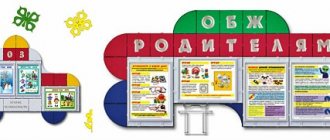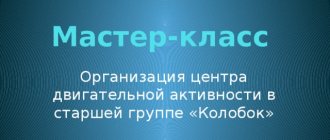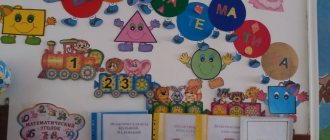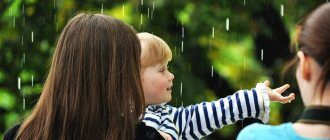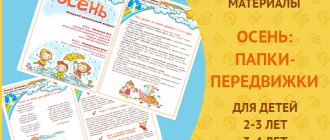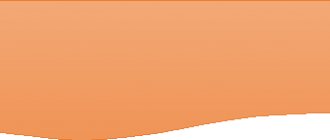Science and Nature Center in kindergarten and senior group
Model of a science and nature center in the senior group of kindergarten
When organizing a subject environment in a group room, I take into account everything that will contribute to the formation of the basic characteristics of each child’s personality, the development of his abilities and interests.
Taking into account the characteristic need for older preschoolers for self-affirmation and recognition of their capabilities by adults, I created conditions for their development of independence, initiative and creativity. The development of cognitive activity of older preschoolers is fully facilitated by the creation of science and nature centers that develop children's interests, curiosity and cognitive motivation; imagination and creativity; form ideas about objects in the surrounding world about the properties and relationships of objects in the surrounding world (shape, color, size, materials, etc.). All materials in the science center meet safety requirements, are accessible to children, and everything is aesthetically designed. The Science and Nature Center is not only a decoration for the group, but also a place for children’s self-development. The Science and Nature Center consists of several mini-blocks: mini-laboratories; corner of nature; methodical corner; corner “I want to know everything”; corner “Nature workshop”; game libraries. 1. Our group is equipped with a “Mini-laboratory”. The laboratory is designed to develop children's interest in research activities, where the development of primary natural science concepts, observation, and curiosity occurs. The laboratory carries out the following types of experiments: * Experiments (experimentation) with objects and their properties; * Collecting (stones, herbarium.)
The mini-laboratory stores equipment and materials necessary for conducting experiments, materials with the help of which children experimentally learn the secrets of living and inanimate nature:
*Special dishes (various containers, trays, measuring spoons, cups, tubes, funnels, plates, strainers ); *Natural material (pebbles, sand, seeds, shells, cones, moss, tree bark, dried flowers, tree branches, etc.); *Recycled material (wire, candy wrappers, polystyrene foam, corks, threads, etc.); *Device assistants (microscope, magnifying glasses, compass, mirrors, various types of scales, etc.); *Medical material (syringes without needles, bulbs, pipettes, cotton swabs, cones); *The world of materials (types of paper, types of fabric, plastic objects, wooden objects, metal objects); *Technical material (nails, screws, bolts, etc.). *For experiments with water: food and non-food dyes, salt, sugar, flour, starch, tea, vegetable oil, ice containers. *For experiments with air: tubes, soap bubbles, balloons, pinwheels, etc. *For experiments with light and color: various flashlights, mirrors, colored pieces of glass (cut from plastic bottles). *For experiments with sound: kinder surprises with various fillings (peas, buckwheat, millet, semolina, etc.), bells, pipes, rattles, headphones. *For experiments with scent: bags with lavender, chamomile, pine, fresheners, aromatic oils, candles, perfume samples, testers. *For experiments with magnets: various magnets, paper clips, metal objects. In addition, we have collected a card index of various experiences and experiments.
In the mini-laboratory there are: * collections: -
Seed collections.
-Herbarium. -Collection of fabrics. -Collection of threads. -Collection of shells. -Collection of stones. *models:
- algorithms of experiences and experiments that serve to develop abilities for mastering modeling activities, systematizing cognitive experience.
*layouts:
-kingdom of ice and snow; -who lives in hot countries; - animals of our forests; - reptiles; -insects.
"Aquarium World"
2. Methodological corner. In the corner there are rules for working with materials, developed together with children, symbols, permitting and prohibiting signs. There are also symbols, various diagrams, as well as information for parents (consultations, recommendations), diaries of observations and experiments on experimental activities, which are kept and filled out by children together with the teacher. 3. Corner “I want to know everything.”
It includes books, encyclopedias “Everything about everything”, atlases, albums: (seasons, trees, flora, mushrooms, natural phenomena, insects, birds, animals of hot countries, domestic animals and birds, wild animals, animals of the North). Timely introduction of visual materials - books, encyclopedias, atlases, albums with different natural communities helps children develop the ability to independently “work” with a book and obtain the necessary information. 4.Nature corner. The nature corner allows you to successfully solve problems on living nature, introduce children to the functions of plant parts, how plants breathe, eat, how they develop, reproduce, what is the structure of plants, the meaning of plants. Indoor plants are presented here. They have a passport for a corner of nature. Experience shows that such a passport is convenient for working in a corner of nature, because Children, guided by symbols, learn how to properly care for plants. Materials for caring for plants are also located. In the corner of nature there are aprons for those on duty, watering cans, a sprayer, brushes, rags, a spatula and a ripper.
Thematic albums are presented: meadow flowers, garden flowers, indoor plants, insects. Models presented: *nature calendar (seasons), days of the week; *calendar of observations of seasonal changes in nature. Nature calendars indicating months, time of day and days of the week. 5. Game library. The toy library contains environmental games, lotto, and puzzles. A card index of games has been created: “Who lives where?”, “Animals”, “Plants are our friends”, “Associations”, “Zoological Lotto”, “Who eats what?”, “Seasons”, etc. In games, children consolidate those knowledge that is gained through experience.
6. Corner “Nature workshop”. This is a corner of independent activity for preschoolers. In this corner, children, getting acquainted with natural materials, create crafts from them. Here there are natural materials (clay, chalk, sand, soil, tree bark, as well as fruits and seeds of various plants) and additional equipment: glue, plasticine, fabric, paper. What the children created - crafts, drawings - is presented in the science center. A mini-exhibition is organized periodically. This is another opportunity for the formation of a holistic perception and understanding of various objects and phenomena of the surrounding reality, a positive attitude towards the world based on emotional and sensory experience.
7. “Vegetable garden on the window.” Plantings: onions, garlic, lettuce, beans, corn, cucumbers, dill, sweet peppers, tomatoes, marigolds. The vegetable garden allows you to organize long-term observations of the growth process of plants and their growth conditions. During the experimental activities of growing plants, an observation diary is kept, in which the teacher, together with the children, records the conclusions drawn from the results of daily observation. Thus, a competent combination of materials and equipment in the experimentation corner contributes to children’s mastery of the means of cognitive experience. By encouraging children's curiosity, quenching the thirst for knowledge of little "whys" and directing their active activity, we contribute to the development of children's abilities in the process of experimentation. If a child researcher finds support from teachers and parents, he will grow into a researcher - an adult, smart, observant, able to independently draw conclusions and think logically, who throughout his life will find something interesting and unusual in the world around him, who knows how to be surprised and happy everything he sees around him.
We recommend watching:
Subject-developmental environment of a group in a kindergarten according to the Federal State Educational Standard Do-it-yourself educational toy for preschool children “Kolobok” Development of information competence of pupils with disabilities in an information-development environment Mathematics center in the senior group of a kindergarten
Similar articles:
Nurturing cognitive interests in children of senior preschool age
Identification of cognitive interests in preschool children
Formation of cognitive interest in mathematics among older preschoolers
Cultivating cognitive interest in nature in children of senior preschool age
Cultivating cognitive interest in book graphics in children of senior preschool age
Methodological recommendations “Content of corners of experimental activities in preschool educational institutions”
Guidelines
“Content of corners of experimental activities in preschool educational institutions”
In the experimental activity corner (mini-laboratory, science center) the following should be highlighted:
1) a place for a permanent exhibition, which houses a museum, various collections, exhibits, rare objects (shells, stones, crystals, feathers, etc.)
2) a place for instruments, a place for storing materials (natural, “waste”)
3) place for conducting experiments
4) place for unstructured materials (sand, water, sawdust, shavings, polystyrene foam, etc.)
Materials in this zone are distributed in the following areas:
- "Sand and Water"
- "Sound",
- "Magnets"
- "Paper",
- "Light",
- "Glass and plastic"
- "Rubber".
When setting up an experimentation corner, the following requirements must be taken into account:
- safety for the life and health of children;
- adequacy;
- accessibility of location
Yogurt cups, ice cream cups, and plastic bottles are used as laboratory glassware. Children are clearly shown the possibility of recycling materials that are thrown away in excess and pollute the environment. This is a very important educational moment. It is important that everything is signed or diagrams are drawn - designations. You can use various jars with lids and kinder surprises.
To organize independent children's activities, cards-schemes for conducting experiments can be developed. Together with the children, symbols, permitting and prohibiting signs are developed. The material for conducting experiments in the experimentation corner changes in accordance with the work plan
In the experimental activity corner the following should be highlighted:
- Didactic component
- Equipment component
- Stimulating component
- Educational books for middle age;
- Thematic albums;
- Collections: seeds of various plants, pine cones, pebbles, collections “Gifts” (winter, spring, autumn), “Fabrics”, “Paper”, “Buttons”
- Mini-museum (various themes, for example “stones”, miracles of glass”, etc.)
- Sand, clay;
- A set of rubber and plastic toys for playing in water;
- Materials for playing with soap foam,
- Dyes - food and non-food (gouache, watercolors, etc.).
- Seeds of beans, beans, peas
- Some foods (sugar, salt, starch, flour)
- The simplest instruments and devices:
- Magnifying glasses, water vessels, a “box of sensations” (a wonderful bag), a mirror for playing with a “sunny bunny”, containers from “Kinder surprises” with holes, substances and herbs with different smells are placed inside.
- “Waste material”: ropes, laces, braid, wooden spools, clothespins, corks
- Rules for working with materials accessible to children are posted in a prominent place.
- Characters with certain traits - (approx. “Dunno”, “Why”, etc.) on whose behalf a problematic situation is modeled.
- Cards-diagrams of experiments (filled out by the teacher): the date is set, the experiment is sketched.
Contents of experimentation corners
Early and younger ages
Contents of components and equipment of the corner
1. Comparison of objects: objects for comparison by size (large-small, higher-lower, wider-narrower, sensory standards, pyramids, inserts.
2. A table with containers for water and sand, aprons, boats, molds, scoops, sieves for sand, transparent water containers of various shapes, cocktail tubes, sticks, funnels.
3. Dry pools, a tray for drawing with semolina and sand.
4. Natural material: clay, pebbles, shells, pieces of wood, cones, fruits, moss, feathers, etc.
5. Seasonal materials, calendars, layouts.
6. Card indexes with descriptions of experiments
Average age
1. A table for experiments with containers for water and sand, aprons, boats, molds, scoops, sieves for sand, transparent water containers of various shapes, cocktail tubes, sticks, funnels, measuring cups, scales, a brush and a dustpan for sweeping.
3. Dry pools, a tray for drawing with semolina and sand.
4. Indoor plants with signs, plant passports and items for caring for them
5. Natural materials: clay, pebbles, shells, pieces of wood, pine cones, fruits, moss, feathers, bulk products (sugar, salt, food coloring, soap)
6. Seasonal materials, calendars, layouts.
7. Magnifying glass, mirrors, transparent containers for observing insects, objects made of different materials, types of paper
8. Card indexes with descriptions of experiments
9. Journal of experiments for sketching the results.
10. Didactic games on ecology.
11. Operational maps of experiments, preparation of simple dishes.
Older age
- Schemes, tables, models with algorithms for performing experiments;
- Series of paintings depicting natural communities;
- Educational books, atlases;
- Thematic albums;
- Collections
- Mini-museum (themes vary, for example, “There are different types of watches,” “Stone products.”
- sieve, funnels
- Halves of soap dishes, ice trays;
- Oilcloth aprons, sleeves, rubber gloves, rags;
- Mini-stand “What I want to know about tomorrow”;
- Personal notebooks for children to record the results of experiments;
- Hint cards (permitting - prohibiting signs) “What is possible, what is not”;
- Characters endowed with certain traits, on whose behalf a problematic situation is modeled.
- Materials in this zone are distributed in the following areas: “Sand and water”, “Sound”, “Magnets”, “Paper”, “Light”, “Glass and plastic”.
The main equipment in the corner are:
- Helper devices: magnifying glasses, scales, hourglasses, compass, magnets;
- A variety of vessels from various materials (plastic, glass, metal, ceramics);
- Natural material: pebbles, clay, sand, shells, cones, feathers, moss, leaves, etc.;
- Recycled material: wire, pieces of leather, fur, fabric, plastic, cork, etc.;
- Technical materials: nuts, paper clips, bolts, nails, etc.;
- Different types of paper: plain, cardboard, sandpaper, copy paper, etc.;
- Dyes: food and non-food (gouache, watercolors, etc.);
- Medical materials: pipettes, flasks, wooden sticks, syringes (without needles), measuring spoons, rubber bulbs, etc.;
- Other materials: mirrors, balloons, butter, flour, salt, sugar, colored and transparent
